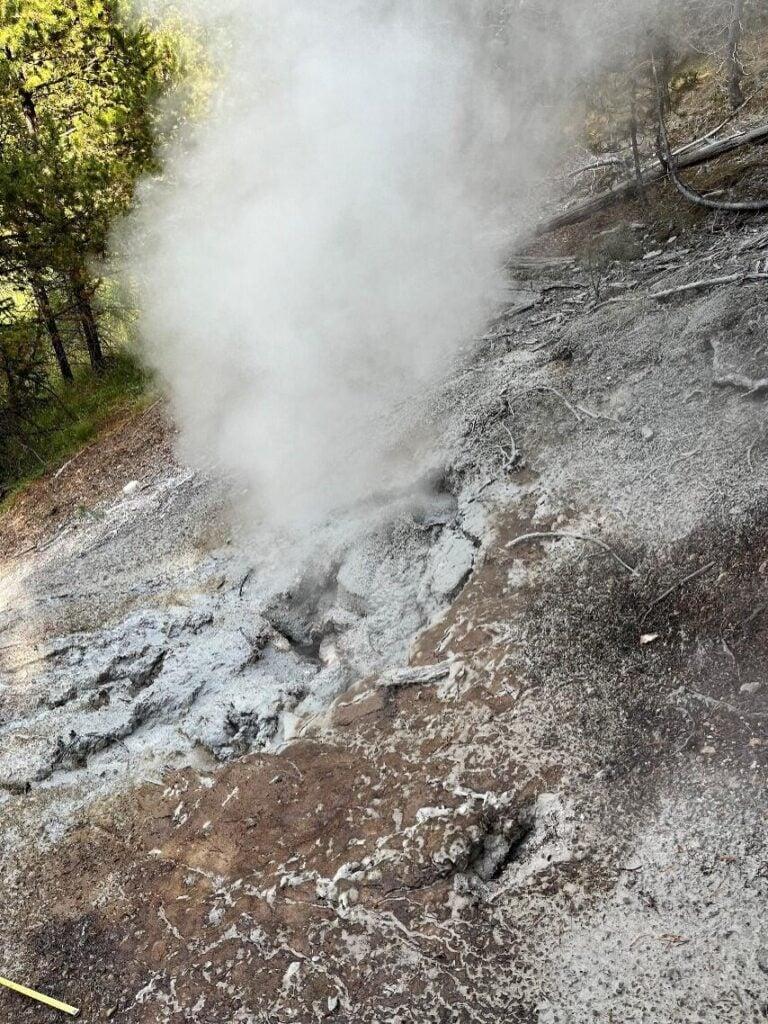This post was originally published on Sustainability Times
Source: Sustainability Times
| IN A NUTSHELL |
|
Yellowstone National Park, known for its breathtaking landscapes and diverse wildlife, sits atop a supervolcano. This geological wonder has recently offered scientists and visitors an unexpected spectacle. In the summer of 2024, a new volcanic vent opened, adding another layer of intrigue to this iconic American destination. As researchers from the Yellowstone Volcano Observatory delved into this phenomenon, they uncovered fascinating insights about the park’s geothermal activity. This article explores the serendipitous discovery, its potential historical connections, and the ongoing mysteries of Yellowstone’s dynamic environment.
The Serendipitous Discovery
The discovery of the new volcanic vent in Yellowstone was an event of pure chance. On August 5th, 2024, a park scientist driving along the highway through Yellowstone noticed an unusual plume of steam rising above the trees. Such a sight in an area without reported hydrothermal activity was striking. A few phone calls later, it was confirmed that a new volcanic vent had indeed opened.
Geologists promptly arrived on the scene to examine this fresh evidence of geothermal activity. They found the vent surrounded by a thin layer of siliceous clay, indicating its recent formation. The escaping steam measured a surface temperature of 77°C, hot enough to deter any curious hands but not sufficient for culinary endeavors. This newfound vent, with its initial robust steam plume, drew considerable attention from both scientists and the public.
As time passed, the steam plume weakened, raising questions about the vent’s future activity. Researchers from the Yellowstone Volcano Observatory speculated that the vent might regain its vigor by summer 2025. Yet, this remains uncertain, underscoring the need for ongoing monitoring to understand the vent’s behavior fully.
5 million years of planetary scars expose the true culprits behind Earth’s deadliest extinctions
A Connection to a 20-Year-Old Event?
The young volcanic vent discovered in August 2024 may have historical ties that extend back over two decades. Researchers have proposed a surprising hypothesis: the vent could be a belated manifestation of a hydrothermal event from March 10th, 2003. On that day, a similar volcanic vent emerged in the same region of Yellowstone, albeit on the opposite side of the current discovery.
Understanding the link between these two events could provide valuable insights into the park’s underlying geothermal processes. The 2003 event, with its analogous characteristics, presents an intriguing case for further investigation. Scientists are keen to explore the geological mechanisms that might connect these occurrences, separated by more than 20 years.
Additional studies are necessary to confirm any relationship between the two vents. Such research could enhance our comprehension of Yellowstone’s volcanic activity and its broader implications for the park’s future.
“Unseen heroes in a petri dish”: these new viruses massively combat climate change now
The Geothermal Heart of Yellowstone
Yellowstone’s geothermal features are among its most captivating attractions. The park’s supervolcano status adds an element of both awe and caution, as visitors and scientists alike navigate its dynamic landscape. The recent vent discovery is a reminder of the park’s ever-changing nature, driven by the immense geothermal forces beneath its surface.
This geothermal activity supports a rich ecosystem, making Yellowstone a sanctuary for numerous endemic mammal species. The interplay between the park’s volcanic and biological components creates a unique environment that draws millions of visitors annually.
As researchers work to unravel the mysteries of Yellowstone’s geothermal activity, they do so with an appreciation for the delicate balance that sustains this extraordinary national park. Each new discovery, like the 2024 vent, provides a window into the powerful natural processes shaping Yellowstone’s landscape.
“As old as dinosaurs”: this massive mammoth tusk unearthed in Texas rewrites history
The Future of Yellowstone’s Volcanic Activity
Yellowstone’s supervolcano remains a subject of fascination and concern for geologists and the public. While the park’s geothermal features offer breathtaking beauty, they also pose potential risks. Understanding the behavior of volcanic vents, such as the one discovered in 2024, is critical to assessing these risks and preparing for potential future eruptions.
Continuous monitoring and research are essential to safeguard both the park’s visitors and its unique environment. As scientists study the new vent and its possible connections to past events, they contribute to a broader understanding of Yellowstone’s volcanic system.
The ongoing dialogue between science and nature at Yellowstone invites us to consider the implications of living in harmony with such a powerful natural force. How will future discoveries at Yellowstone shape our understanding of the delicate balance between geothermal activity and the park’s ecological vitality?
The post “Unbearably hot”: A massive volcanic vent opens in Yellowstone, unleashing this immense heat and raw energy appeared first on Sustainability Times.


 A new volcanic vent was discovered in Yellowstone, highlighting the park’s dynamic geothermal activity.
A new volcanic vent was discovered in Yellowstone, highlighting the park’s dynamic geothermal activity. The vent was found by chance on August 5th, 2024, when a scientist noticed an unusual steam plume in the park.
The vent was found by chance on August 5th, 2024, when a scientist noticed an unusual steam plume in the park. Researchers speculate the vent might be connected to a similar event from 2003, showcasing Yellowstone’s geological mysteries.
Researchers speculate the vent might be connected to a similar event from 2003, showcasing Yellowstone’s geological mysteries. Ongoing research aims to understand the implications of these geothermal phenomena for the park’s future.
Ongoing research aims to understand the implications of these geothermal phenomena for the park’s future.


0 Comments